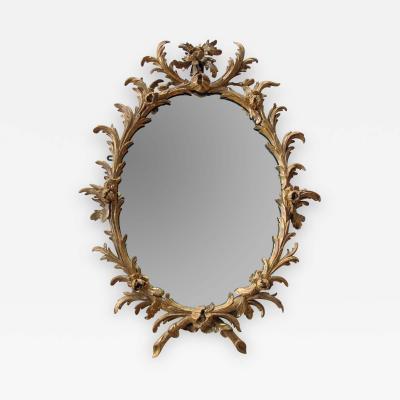Incollect Designer Focus: Glenn Gissler
 | |
Glenn Gissler. Photography by Gross & Daley. |
With degrees in architecture and fine arts from the Rhode Island School of Design, interior designer Glenn Gissler brings a rich knowledge of art and culture, ranging from classical Greece to contemporary New York, to his residential projects. The Manhattan-based designer has developed a cultivated eye over the years through strong relationships with the city’s leading auction houses, dealers, and artists. A member of the RISD Museum board and current president of the New York chapter of the American Society of Interior Designers, Gissler takes an alchemical approach to designing and furnishing home interiors.
“It’s never just about beautiful décor,” he says. “Every assignment involves taking a comprehensive view, one that integrates all the elements—architecture, art, antiques, furniture, textiles, and objects — through the specifics of the client’s personality and lifestyle.” This client-centric approach results in highly livable interiors that enhance the physical and imaginative lives of the people who inhabit them — rooms that offer multidimensional, enriching experiences for the mind and the senses. To this end, Gissler often helps clients assemble significant art collections, lending them his expert advice in the ongoing development of their own eye.
 |
 |
| Harmonies in rich reds, ebonies, and honey tones are exemplified by the custom wool area rug from Martin | Patrick | Evan; the Chinese camphor wood altar table from Shanxi Province, ca. 1850, acquired from Pagoda Red; and textiles from Donghia and Gretchen Bellinger. An aquatint etching by Cubist artist Jacques Villon is posed on a cast-iron artist’s easel. The Austrian chairs, ca. 1956, designed for the Vienna City Hall by Roland Rainer and manufactured by E. & A. Pollack, are from Kimcherova. The art on wall was commissioned from Jacob Hashimoto. Photography by Gross & Daley. |
Art in Situ
For the clients living in this classic ten-room apartment on Manhattan’s Upper West Side, we mixed mid-20th-century design with traditional forms of furniture that speak to supreme comfort. This residence fuses luxury with restraint, comfort with discipline, and fine art of the highest order with consummate works of decorative art. It represents a lively and inspired collaboration between clients and the designer in creating a new collection, and implanting its art and artifacts in a home as livable as it is stylish.
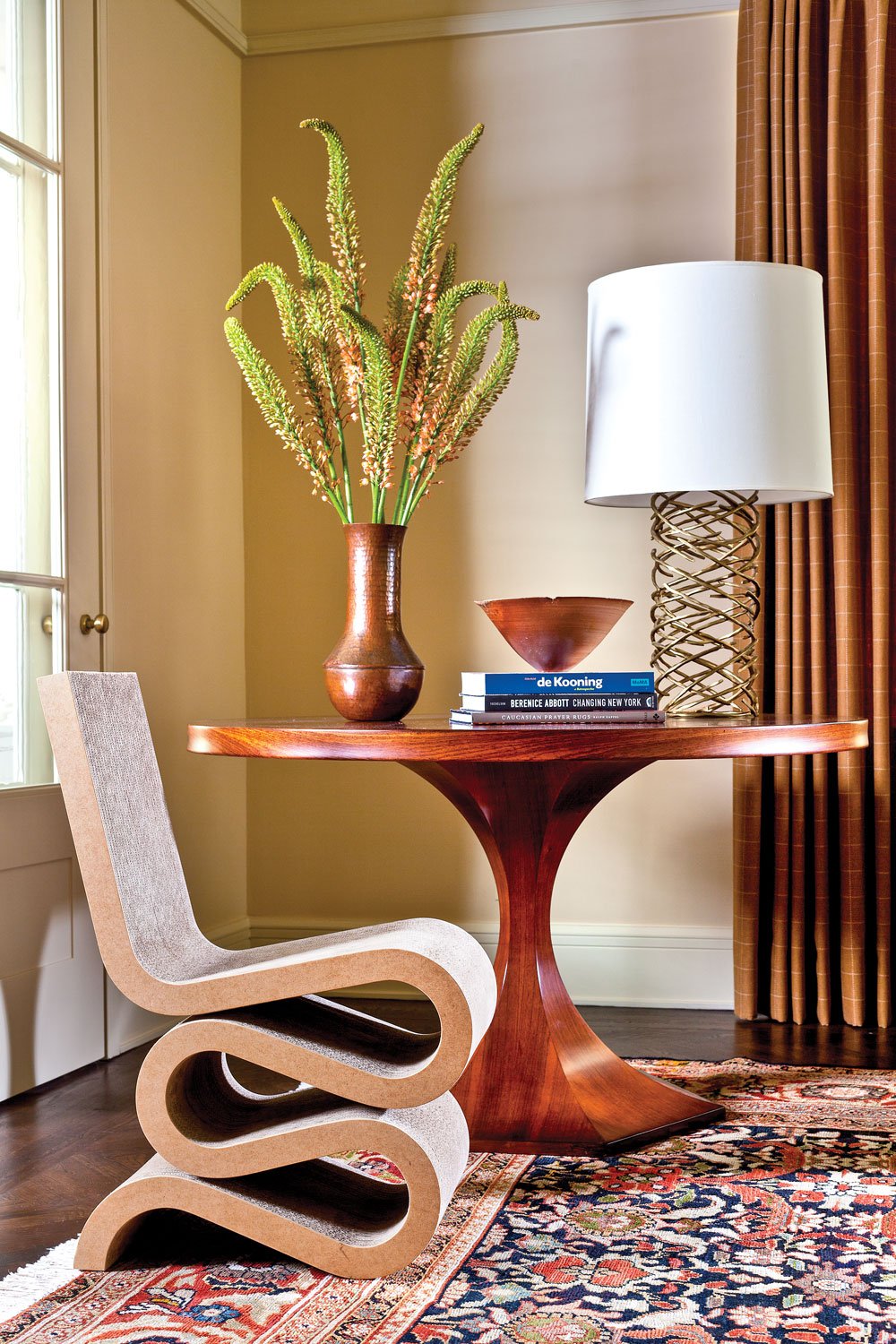 |
Seen with a magnificent Sultanabad carpet, ca. 1900, and plain yet luxurious draperies, contemporary objects, such as architect Frank Gehry’s corrugated Wiggle chair, 1972, take on new resonance and context. Placed in a corner of the living room, the curves of the Danish Modern rosewood pedestal table, ca. 1950, echo those of the chair and of Hervé van der Straeten’s Tornade lamp. Photography by Gross & Daley. |
 |
Picasso’s portrait of Dora Maar (1939–1942) hangs above an Ethiopian carved wooden chair, ca. 1900. On the adjacent wall, above German-American designer Tommi Parzinger’s mahogany and brass cabinet, ca. 1950, and a mid-century tripod lamp, hangs a drawing by contemporary artist Terry Winters. The custom carpet is by Martin | Patrick | Evan. Photography by Gross & Daley. |
 |
 |
In the entry hall, gleaming dark wood floors contrast with a custom interpretation of a 1954 Gio Ponti rug, originally in cowhide but now handmade in wool by Martin | Patrick | Evan. The photograph of a rough, peeling wall is by German artist Frank Thiel; the large work on paper at left is by Julian Schnabel. A porcelain sculpture, Aktaeon, by Arno Malinowski for Royal Copenhagen, ca. 1937, from Hostler Burrows, is placed atop a lacquered Chinese altar table, ca. 1900, from Pagoda Red. Photography by Gross & Daley. |
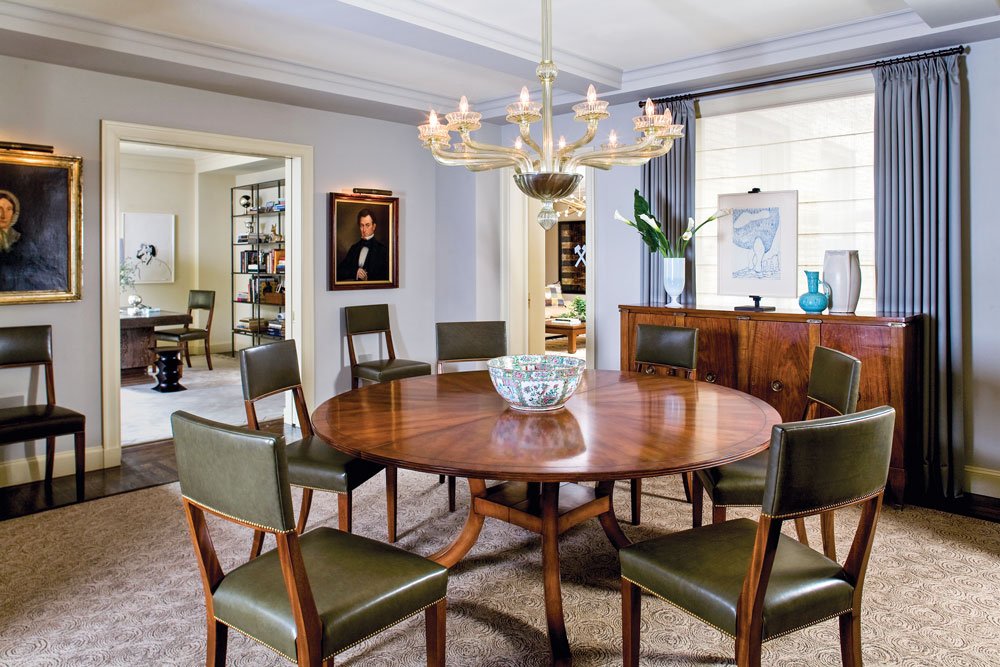 |
Gilt-framed family portraits flank the entry of the dining room, with a view into the living room. The pearwood dining table is from Holly Hunt and the custom Russell side chairs are from Dessin Fournir; a 1940s style Venetian Murano glass chandelier hangs above the table. An Italian fruitwood cabinet, ca. 1927, by Gio Ponti and Emilio Lancia is the setting for a Louise Bourgeois drawing presented on an easel. Elegant plain curtains in Holly Hunt’s “Colonial Pewter” fabric frame the tableau for these Modernist icons. Ceramics, including a Sevres vase, Christopher Dresser pitcher, and a circa-1910 large American vessel, complete the vignette. Photography by Gross & Daley. |
Gracious Eclecticism
Originally two units, this eleven-room Park Avenue apartment on Manhattan’s Upper East Side is in a building designed in 1923 by architect Mott B. Schmidt. The clients sought an interior that would be both stylish and livable for their family. The spare yet luxurious neoclassicism of French 1940s design appealed to these collectors of contemporary art. They also had inherited a collection of American furniture and decorative arts. The designer’s brief was to achieve an airy, spacious aesthetic in the public rooms, while integrating the family’s earlier furniture and art into the cozier private spaces. In every room, works of fine and decorative art are layered in eras of texture. It is a home for art lovers, as comfortable as it is beautiful.
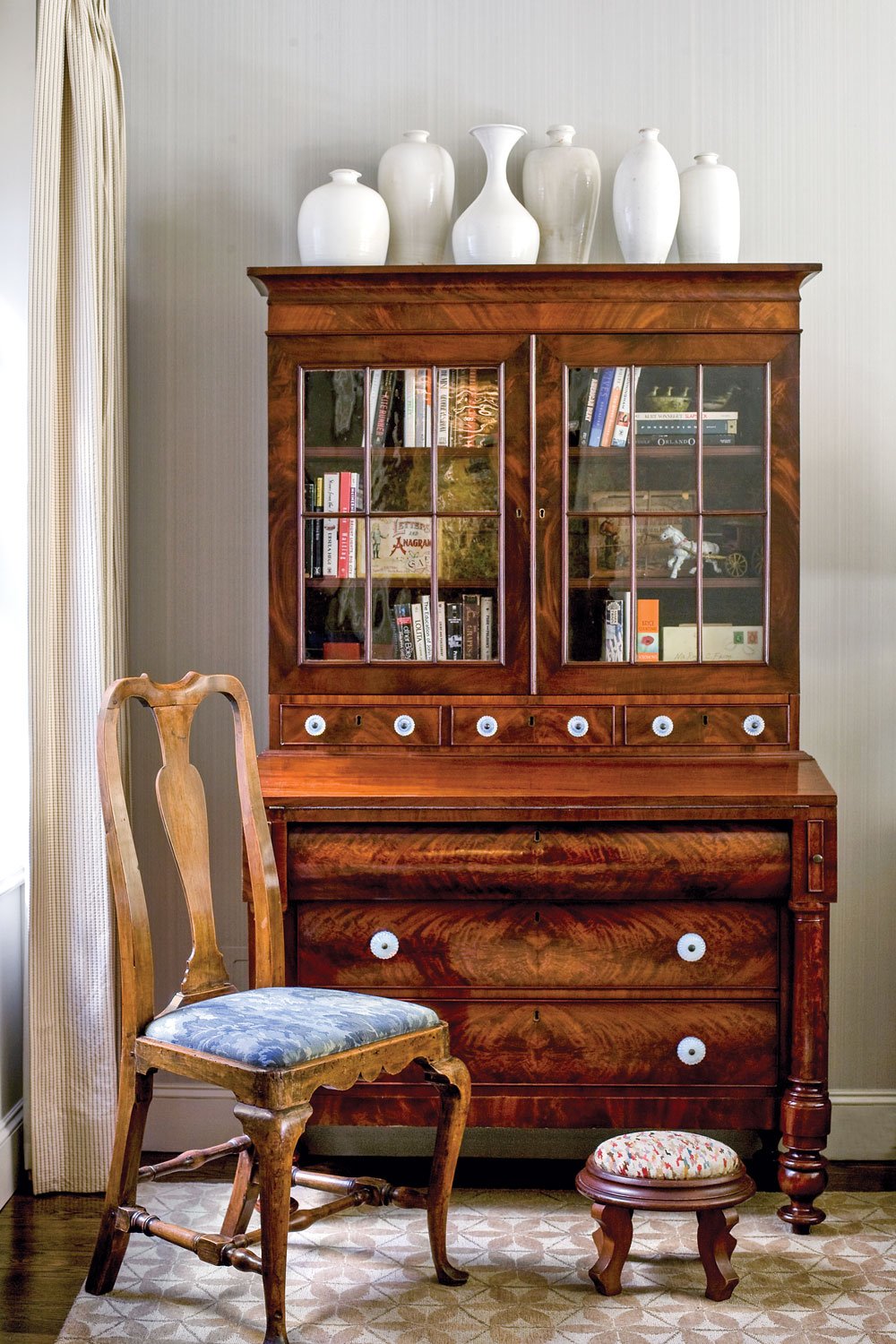 |
A collection of white-glazed Chinese pottery graces an American antique secretary—a family heirloom. The custom wool and silk rug from Tai Ping, is woven to resemble a needlepoint pattern. The crisply pleated curtain fabric is “Palazzo Check” from Holly Hunt; the custom strié wallpaper is from Farrow & Ball. More family heirlooms, a Queen Anne chair and footstool, complete the space. Photography by Gross & Daley. |
 |
Contemporary Manor House
The gabled rustic-stone structure by architect Tasos Kokoris has vast expanses of steel casement windows and is reminiscent of a country manor house designed for William Randolph Hearst in the early twentieth century. For this project, we had carte blanche on designing all aspects of the interior. The public spaces invite entertaining on a grand scale, yet they never lose their warmth and dignified informality, largely achieved by concentrating on a repertoire of rich, resonant materials — artisanal plaster, cerused oak paneling, planed stone floors — and a muted palette of taupes and driftwood grays, which, rendered in the pigmented plaster, achieve a subtle glow.
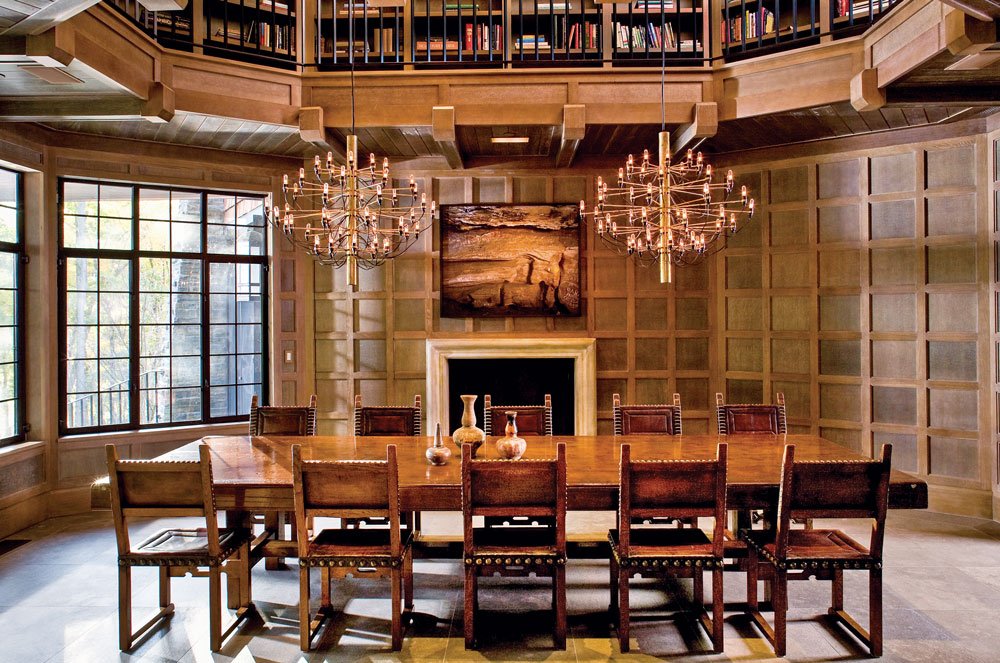 |
The double-height dining room, with a library catwalk above, is a tour de force of light and shadow. Above the mantelpiece is a photograph of the interior of a cave by Jeff Whetstone; similar in tonality to the cerused oak paneling, it seems to have been created just for this room. The chairs, with their original leather upholstery, are French, ca. 1900. The enormous refectory table is custom; the vintage chandeliers are by Gino Sarfatti. Photography by Gross & Daley. |
 |
 |  | |
| Left: A French 1940s console attributed to Jean Pascaud, with doors of inlaid shagreen and bone, creates a serene tableau at the end of a hallway. A pair of classic signed Tiffany candlesticks, ca. 1900, from Ophir Gallery, are patinated bronze with an “organic root” base. Stiges hand forged iron sconces from Roman Thomas are oil-rubbed with stitched silk pearl shades. The 1969 work, Untitled, is by New York artist Harvey Quaytman. Photography by Gross & Daley. Right: Custom upholstered furniture with a rich selection of textiles, art, and antiques make this living room both supremely comfortable and visually interesting. The throw on the recamier, fabricated from a vintage black and red cape from Sumatra, is from Sarajo. The luxurious area rug is vegetable dyed and hand-knotted Tibetan wool. A pair of ca. 1950s giltwood table lamps complement the Christopher Dresser brass firedog, ca. 1890, on the custom woven leather upholstered coffee table. The ca. 1930s walnut chair in the foreground is by Czechoslovakian architect Lajlos Kozma, and the artwork on the wall is by Jacob Hashimoto. Photography by Gross & Daley. | ||
A Curated Family Loft
The clients purchased a 3,000-square-foot raw loft in a converted former warehouse near Lincoln Center in Manhattan. Challenged by a scarcity of natural light and impractically long, dark hallways, we reconfigured these spaces into a human-scaled dwelling, suited to entertaining and to more intimate family time alike.
The furnishings, a mix of custom contemporary pieces with 1940s French design, are a lively array, preserving the downtown Greenwich Village edge of the family’s former residence while lending a greater level of comfort and elegance to the new loft. Layers of African and Asian textiles and artifacts augment the distinctive eclecticism of the rooms.
 |
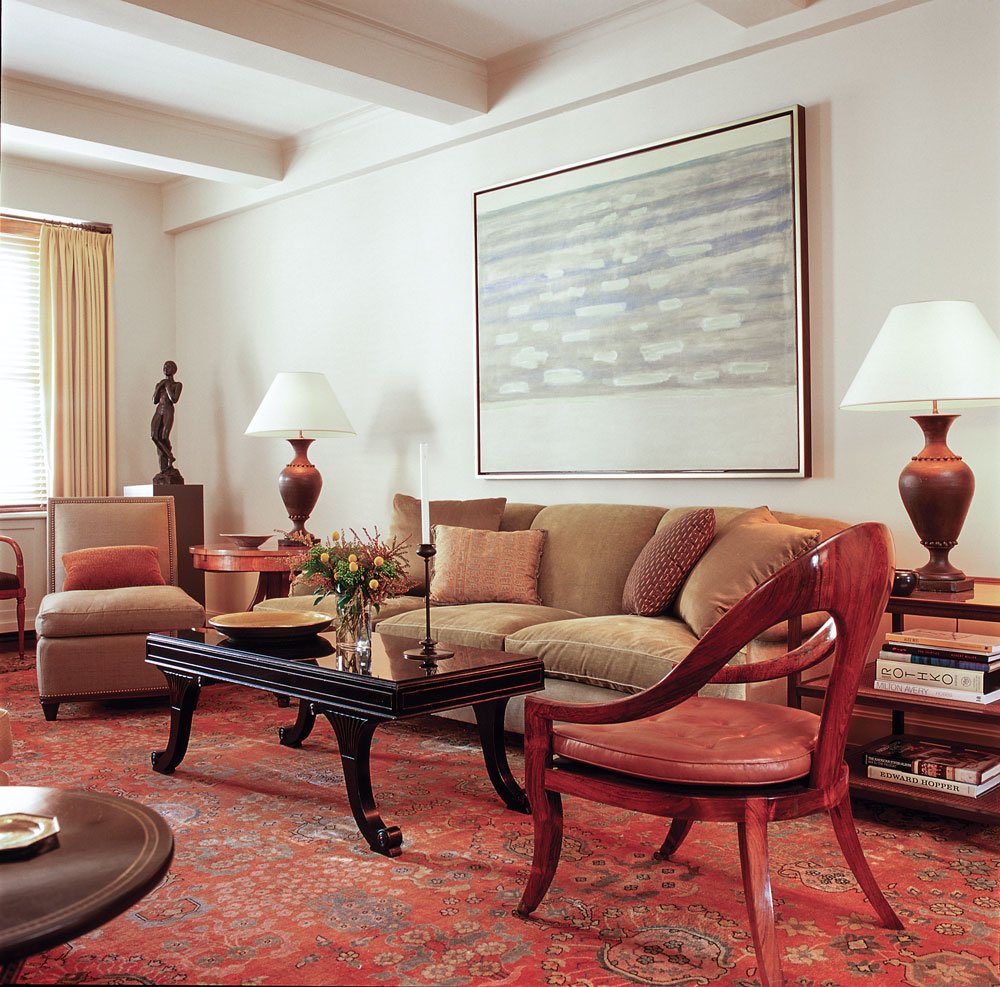 |
| A subtly faded antique Sultanabad rug with elements of blue and coral in its pattern lays the groundwork for this living room, dominated by the Milton Avery seascape above the sofa. An Empire spoon back chair and Parsons slipper chair add comfort as well as style to the ensemble. The bronze figurative sculpture is by Georg Kolbe, whose work was included in Mies van der Rohe’s Barcelona Pavilion of 1929. Photography by Gross & Daley. |
New Traditional
The clients in this Upper East Side apartment already possessed an eclectic array of English Regency Revival furniture juxtaposed with French 1940s pieces. They had also collected a significant collection of 20th-century paintings and photographs punctuated with such names as Helen Frankenthaler, Milton Avery, and Alice Neel. These works are surrounded by equally interesting, sometimes curious pieces of furniture. The artwork also inspired the palette: ochre, amber, sepia, ebony. The result is a small but engaging dwelling in which every corner possesses aesthetic value. The luxury of finely-crafted upholstery makes this apartment a place to be at ease with art as well as to enjoy both entertaining and private life.
 |  | |
| Left: The 19th-century industrial light fixture with mirror panels, retro fitted for residential use, hangs above a Regency style pedestal table and 1940s American dining chairs, trimmed with brass upholstery nails. The mirror reflects a painting of a street scene by realist artist Alice Neel. Photography by Gross & Daley. Right: Among the additions to the client’s furniture was a tall Art Deco coin cabinet; an expressive 1950s Italian pitcher is placed on top. The angles of the 19th-century English hall chair evoke modernity, complemented by an early 20th-century black-and-white WPA engraving. Photography by Gross & Daley. | ||
 |
 |
Glenn Gissler Design
1123 Broadway, Suite 1100
New York City
212.228.9880
















